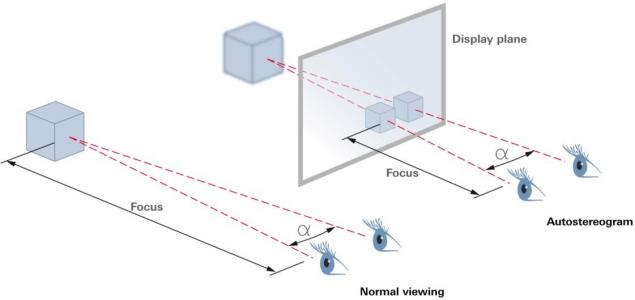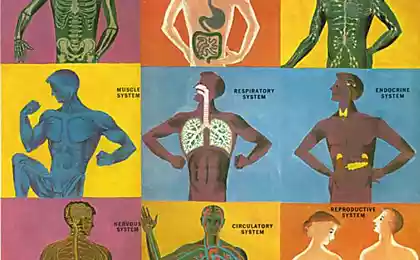829
Why 3D headache

The question is, why do people get a headache from 3D very mythologized. Journalists repeat each other, which, in General, is important, but the importance of which is on the 10th place, and about absolutely outrageous things like multiple savings on the equipment of cinema or about a massive magical mistakes on the filming and post-production is almost all silent. Very many problems if you ask for, it's easy to see, that is, to the naked eye if you know where to look and are relatively simple scripts.
Part of the problem are harder to catch but after they found — "enjoy" them is also easy. A typical example is the messed up camera angles (right confused with the left). Debunking myths and real problems, their reasons and in varying degrees, ways of their correction and will be dedicated to a series of articles "Why 3D headache."
A large part of their income to the film makers still get from cinemas. In recent years significantly increased sales of the so-called "home theater" that leads to new technical methods to increase visual quality and entertainment movies in the common rooms. Otherwise, the flow of people into the theaters will fall, which will provoke a crisis in the industry. Again, we are talking about technical issues, forcing people to go to the cinema and to increase box-office pictures. The artistic merits of films, through which each first downloads them from a torrent and watch at home certainly increase the audience, but their impact on box-office below, we will not be considered. Let we already have a decent interesting film and it people have a headache, why is this happening?
From the point of view of technical video formats, the development goes in three directions:
Higher resolution (4K instead of 2K); the Increase in frame rate (HFR — High Frame Rate); Adding volume (increased number of halls with 3D support). At the time surveys were conducted of the attractiveness of these technologies for the viewer. In the end it turned out that increasing resolution the least attractive. Even specially made commercials, many viewers do not see the difference when further increasing the resolution. If you jump from 720×576 to 2K most people see well that the visual difference between 2K and 4K is much less noticeable. Moreover, with increasing age it often becomes physically (physiologically, if you will) is not visible, even if the person wears glasses. Increased frequency also notice not all people celebrate only sharpening when objects move. The vast majority of respondents clearly see the difference between 2D and 3D versions of 3D films and finds very attractive. All this would be fine, if not one big “BUT”: from 2 to 20% of viewers (depending on film and cinema) complain of headache that occurs when watching 3D. People who have a “3D headache” - even if they so prefer to go slow and will not go to 3D versions of movies.
French portal lesnumeriques.com in 2011 conducted a survey of how people feel after watching 3D:
- 33% of respondents watch 3D video without any problems
- 27% feel some discomfort
- 22% complain about deterioration of health
- 7% experiencing severe headache
- 11% after watching a 3D movie note other symptoms of ill health
- 38% — why go To the movies, 2D or 3D — still
- 29% — In the movies go, I prefer 2D, I do not like stereo
- 19% — In the movies go, I prefer 3D if possible
- 12% — In the movie, don't go or rarely go
- 2% — What is cinema?

I.e., the number of those who prefer a 2D one and a half times more people who prefer 3D. Interestingly, regarding television answers “No TV”, “TV is, but do not look” and “basically do not look” up to a 71% and 23% — “rarely Watch”. In fact were interviewed people creative and active, who have no time for TV, but that you go to the movies.
Also the author of these lines many times had to make presentations about the quality of 3D movies and polls the audience statistics looks similar. Almost everything looked 3D at least once been faced with discomfort, and many do not go to 3D movies because when experienced significant headaches.
What is a headache from 3D?
If you do not take deviations in binocular vision of man, that there are two main reasons:
The shortcomings of the equipment;
The shortcomings of the film itself. Discomfort due to the equipment Briefly consider what is wrong with the equipment. Cinema is a business whose owners actively thinking about profit, and therefore strive to reduce costs and increase revenues. Does it have an impact on the quality of the 3D?
Try to understand:
- Speaking about the discomfort of 3D movies, journalists (overwriting the materials of each other) the first thing to write about “the conflict of accommodation and convergence”. What do these words mean?

When a person shifts his gaze from one object to another, first it moves the eye so that the object is not double vision — this is called convergence. Then “restore focus” by changing the curvature of the surfaces of the lens is accommodation. In life the point of convergence and accommodation coincide and are on site. The conflict of accommodation and convergence while viewing 3D is that the image we should always see a clear point of accommodation (focusing) is on the screen, while the point of convergence moves, flying in the room and objects behind the screen.
The problem is definitely there, but it is interesting that for cinema it is less critical than for home TVs and especially 3D laptops and tablets. For example, in the cinema, at a distance of 15 metres from the screen, the scatter of apparent depth of objects is conventionally from 7 meters to infinity (i.e. “setting the focus” almost all the time tuned “to infinity”), and when viewed on the laptop screen at 40 cm from the screen conventionally, a comfortable range from 30 cm to infinity. It is obvious that in the second case, the difference in the focusing of the eye is much more noticeable and potentially diskomfortno.
Conclusion: “the Conflict of accommodation and convergence” is of course the fundamental issue with 3D, but it rather stimulates the going to the cinema, rather than Vice versa, since this parameter (with quality content of course) the more comfortable 3D, the farther the screen is from the viewer. - More revealing is the situation with the so-called active points.

Active glasses alternately block the image to the right and left eyes. Eyes get picture only from their own viewpoint, which allows to generate a three-dimensional image. Plus such a system for the owner of the hall that you do not need to be changed (expensive) screen, and sometimes you don't need to change (also quite expensive) projector. It is sufficient to set the system synchronization points with the projector (special infrared diodes illuminating the screen) to establish the charging and wiping glasses. (The latter, incidentally, can save! ;).
The problem is that such systems have several significant disadvantages. First, many people see flickering even in spite of its high frequency. The producers that are trying, of course, to do with it. In particular for 3D TVs has models in which frequency is raised to 200 Hz, but this increases the cost of the equipment (including points). Second, for the brain is really an atypical situation when he sees an image, then right, then left eye. This significantly adds to the fatigue. The Japanese had a great study, the statistical significance of which is undisputed: they made 500 volunteers to watch 3D and 2D in the active glasses and very convincingly proved that the major share of fatigue give active points, i.e. when viewing 2D movies people are tired of them as much - [1]. Third, the alternate display gives the time shift on poledra (in the best case a little bit less). Based on the frequency of 24-25 frames per second and resolution FullHD, you can calculate the shift in pixels if the main character over pulsecode puts his hand vertically through the frame. The problem is that our eyes see a completely impossible picture when one eye movement noticeable behind the other, and “hands are in different places.” Note that for the horizontal movement, this shift leads to the fact that moving faster(slower) background object fails (moves forward) depending on the direction of movement of the camera. Again, impossible in the real life picture.
- Finally, active glasses seriously lower the brightness. Yes, ideally, falling only twice, but twice would be the case if open points would be missing 100% of the light (which is not), if they had a perfect sinhronizovani (what is wrong) and if it instantly changed its state (again not so). In the harsh reality, for example, glasses in the open state are much less time than in a closed, in order to facilitate synchronization, etc. In the end, the active glasses TVs very famous Korean company lowered the brightness to 7 (seven!) time. If the screen brightness is insufficient, the eyes begin to strain trying to see the details and fast enough... tired. And this in addition to fatigue the flicker. But that's not all! Active glasses also weigh significantly more. This is especially important for those who wear glasses and who have to put on some glasses and watch the movie in two glasses. More likely this affected the owners of expensive points become accustomed to the convenience and light weight glasses normal.
Conclusion: take care of your health! Do not go to cinemas, with outdated active glasses! But if you are not lucky you have a TV with active glasses — see 3D on it only in a darkened room, turning off all light sources, including energy saving lamps (they happen to interfere with twinkling points, significantly adding to fatigue and increase the chances of "3D headache"). - We talked earlier about the importance of high brightness 3D. Actually, if you read professionals, they are about brightness and fatigue from “dark 3D” write constantly. Journal Projectionist at No. 3, 2013 led measurement luminous efficiency of 3D systems, made by Alexander Musinova :
System Brightness, foot-Lambert XpanD masterimage AD1000 6,3 9,7 Clarity3D SA masterimage Wave3D 6,2 masterimage RealD XL DUAL3D 10,1 9,4 2,2 Dolby 3D
It is clear that the measurements are performed in a specific room, with specific systems, but now you know that the brightness in the same room with different systems projector glasses can vary 5 times even if we exclude from consideration by the IMAX system (the brightness of which is only due to the two projectors can be twice as much, but there is still patented and very bright lights!). I hope it becomes clear for what value IMAX? As practice shows, people are pretty poorly distinguish changes in quality even by tens of percent, but the difference in brightness in 10 times they still can see and appreciate. By the way, remember the measurement result for Dolby 3D, we will need it below.
With passive glasses (RealD or Dolby 3D) the situation is better, but not perfect either. In particular, almost always it is displayed with a projector in front of which is a special nozzle that ensures consistent display of images for left eye and the right eye. With this approach, the flickering remains, and hence the associated headaches in some people), but the visibility of the flicker and the brightness fall less. But people still complain. By the way, for RealD polarizing glasses need to change the screen on a more expensive, significantly for owners of the halls (Dolby 3D allows you to save money on changing display that we again remember). - And finally, I love IMAX halls — they are passive glasses and two projectors: one for the left and right eyes. So there is no flicker (to most immediately felt better) and at least twice as physically above the brightness of the screen (is also from less fatigue). At the moment, these halls have the best quality. BUT! And here in our harsh reality all is not well. In particular for spring 2014 in all the halls IMAX, even in relatively wealthy by Russian standards, Moscow has used linear polarization, not circular (as in many IMAX halls, for example, in the USA). This means that if you tilt your head 45 degrees the viewer sees with equal brightness-left and right perspective images to each eye simultaneously. When tilted to 15 degrees — the other view “shines through” conditional on a third. The translucent effect is called crosstalk and it is believed that its maximum value for comfortable viewing — about 2% [3].
- As an exercise, you can remember high school TRIG and calculate how many degrees the head can tilt. At once I will tell — will be a very small number. So you better sit perfectly straight, but not like you usually used. Do you tilt your head when viewing stereo in principle not the best idea, because the image is formed directly under a seated person and when you tilt appears so-called a vertical parallax (vertical shift). If you have circular polarized glasses, tilted head he appears only, but if linear, then the parallax and crosstalk (Hello discomfort!). The quality of some films particularly depends on crosstalk. For example, in “Gravity” has a large number of high-contrast scenes — astronauts in space (white objects on black background). In this situation, even small crosstalk greatly hinders comfortable to watch a movie.However, dramatically higher brightness and lack of flicker are two huge advantage, thanks to which people, focusing purely on your feelings, experience IMAX. I note that the equipment of such rooms costs significantly more expensive.
Conclusions (from the pack):- The difference in brightness between IMAX and “other producers” can reach 10 times (!), that fundamentally improves the comfort of viewing and reduces fatigue.
- Occasionally the owners of the halls put in a small room a powerful projector (called “for themselves”) that markedly increases the brightness of the screen. Find out if there are halls in your city.
- When you view the film, take the time to look, rate one or two projectors Shine on the screen. If one (most likely situation), then even with passive glasses, you will have flickering and all its associated charms.
- Looking ahead — 3D movies also differ in brightness, in the worst case — up to 5 times (!). Usually dark, for example, all “horror”. Are you sure you should go for them in 3D in the room with the “dark” equipment (brand of equipment usually provided on the glasses)? I would like to save you from additional unplanned suffering.
- If the sisters on earrings to give away — sometimes even save on the little things. For example, the IMAX Mega-Teply Stan, after upgrading, the hall is not draped ceiling above the stage. He brushed and lacquered panels pretty much reflect the screen. The reflected light is polarized (Hello physics!), and glasses with linear polarization (Hello savings!), therefore, the glare of the ceiling in one eye are much stronger than in the other. This effect is found in the work of the “points of driver”, only the corner of polyarizatsii the same, and suppressed the glare from the road in both eyes, and here only one. As a result, when viewing an effect of “stromlinie” when you have different eyes see a different picture — or rather, different brightness glare on the screen. For 2D movies, it doesn't matter (where glare would be the same), and 3D session conventionally, your cerebellum will be quiet to suffer in bright scenes, as if to imply the rest of the head — “And it may well, it is 3D?”. In fairness, such problems are unfortunately common for other technologies, for example not uncommon halls with Dolby 3D, which is output from the side of the screen. On output, according to the rules of fire safety the entire session glow appropriate signs. And all anything, but the filter used in the plates has a green tint, the filtered points (from Dolby used the division of the spectrum), in the end, the inscription is significantly different brightness for the right and left eyes (also “strobic”). It is clear that your attention is focused on the center of the screen, so the writing flickers somewhere on the periphery of, the entire session irritating the brain even for those who doesn't know about it (oops, now I'm afraid you won't be able to walk to some rooms with Dolby 3D! ;). Because when it is know, the sign output is starting to irritate specifically. Let's hope this encourages the owners of the halls to set the labels so they could be seen from the aisles (and, alas, the extreme series) and not from the center of the room, as it is now.
Conclusion: Shtroblenie clearly visible. Simply alternately close the left and right eyes to clearly see it. With some training you will understand that the discomfort comes from shtrobleniya even without closing the eyes. Unfortunately with the current quality of rooms such trainings will be more often than I would like. Feel free to write online reviews about the gym, if you see that there are shtroblenie. The owners of the hall will think about the problem only if you will understand it and will publish. - In total according to the Laboratory DSP24 [4] in January 2014, more than 3,000 halls in Russia are equipped with 3D systems:
The name of the 3D system All rooms Share Dolby 3D 1327 42.9% of XpanD 3D 495 16.0% by Volfoni 313 10,1% 5,7 177 MasterImage% of RealD 151 4.9% of IMAX 32 1,0% GM X-Mirror 19, or 0.6% Hi-Shock 18, or 0.6%, Other/no 561 18% total 3093 100%
43% is the Dolby 3D (so Why share? Right! Substantially affect the price of installing the system as this affects the brightness and the flickering you remember). 16% — XpanD 3D, and some of these halls — halls with active glasses (poor people...), 10% — Volfoni (can be either active of passive glasses), 5.7% and 4.9% MasterImage and RealD is pretty high quality passive systems (conventionally 10% together) and 1% IMAX (highest quality, but also expensive facilities). While 18% are “Other” category, which many Chinese manufacturers. Unfortunately people are not very familiar with the topic and are confident that 3D in an expensive room and cheap 3D — are the same. In practice it is not. Your chances to get into the hall with good equipment you can count yourself.
The conclusion need? Well! The refurbishment of the rooms costs money, and someone saves you, and someone decides to invest.On your place I would not skimp on your health, and would walk only in the halls with expensive good equipment. - There are many different important points (for example, the geometry of the hall). Unfortunately there are even IMAX (i.e. check before starting) halls which were converted from regular 2D and in which it decided to establish chairs in a wider area than the area comfortable 3D viewing. In these halls is definitely better to miss the premiere than to watch a movie with the "wrong" places.
Conclusion: Watch 3D movies only from the center of the room, or as close as possible to them, even if there more expensive. - Absolutely wonderful history of testing halls before the screening of the first Russian IMAX 3D film "Stalingrad" was told in the penultimate CG-Event. According to the author of the report, the condition of many 3D halls in Moscow alone, very depressing. We witnessed a total savings on quality projectors, screens, lamps, glasses, chairs, regular tuning equipment, etc. In this case the owners of the hall have stated some characteristics, when “touted” to organize a premiere at your gym, and practice characteristics (including brightness) is much lower. Briefly and constructively, then we can recommend to go to those gyms that show premieres. At least to the premiers of the equipment set up, and with the same ticket price the quality can be much higher. Thus it is necessary to soberly realize that one of the methods of saving used by cinema, is to put more expensive and brighter lamp for the premiere, and then replace them with more cheap on conventional views. Since good lamp is quite expensive — it also allows you to save, alas, due to the increase of the percentage of the audience feeling discomfort from 3D.
Conclusion: Pay attention to what halls show premieres. Believe me, these rooms choose, and the equipment was set up more often.
“However, the bigger issues are the lack of consistency and quality in exhibition. There needs to be pressure put upon distributors and exhibitors to keep the bulbs bright, clean the eye-wear, and regularly measure the illumination from the screen. No matter how well we create S3D, it is getting lost in all too many theaters world wide.”“However, the greater problem is the lack of consistency and quality when showing it. Need to put pressure on the distributors and owners of halls to maintain high brightness, clean glasses, and to regularly measure the light flux from the screen. Regardless of how well we will do S3D, this quality will be lost in huge number of theaters all over the world.” I.e. terrible quality 3D rooms in cinema really discourages producers to clean up small errors in stereo appeared in the stage production. They still get lost on the back of cheap Chinese equipment and bad settings in 99% of rooms.
Fortunately, not all that bad. In particular, the rapidly progressing 3D TVs and home theaters. If what is offered as the big innovation for big money in 2010 to compare with what is available as an additional free option in 2014, the contrast will be striking. For dramatically less money now offers dramatically higher quality. For example, are gradually being replaced by models with “golosovanie” active glasses, crosstalk is reduced, increasing the brightness in 3D mode, 4K TVs with passive glasses are no longer lost half of the lines of the stereo image — all this dramatically increases comfort when watching TV. Moreover, Russia's ability to display 3D have approximately 25% of the sold TVs (in fact, all top models).
And in Asia today, the percentage of models sold TVs with support for 3D already comes to 75% (all models, except the cheapest). As not without pride the Chinese have concluded — “we Have a difficult to buy in the store with a TV without 3D support, so need to specifically look for!” The quality of the new models continues to grow. As a result, today comfort when viewing on a nice big screen TV with passive glasses in a dark room can be significantly higher than the average theater.
So if your city at the cinemas only cheap equipment (terrible dark 3D picture), it's best to buy a modern TV with passive glasses (looking at his performance and after reading the reviews). And equipment in the halls will gradually replace, simply because the new projectors to cinemas today, first, also massively support 3D, and secondly, doing it better and better.
For example, a fresh trend is the emergence of so-called "laser projectors". “Laser” models offered by several manufacturers of projectors (including Chinese). Their laser projectors makes IMAX. Of the key points — they are very high brightness and initially only passive glasses. For owners of halls it is also important that laser takes approximately 5-10 times longer than conventional lamps in projectors. As a joke some professionals "with laser projectors over the dark times 3D". Reviews of people closely related to visual effects watching the movie with a laser projector often heard in the key of "watched the old movie as a completely new", i.e. many parts never to be seen. Don't expect too much to soon, apparently laser projectors will go through a few teething problems before the quality will be consistently high. However, expensive high-quality laser projectors today do allow to show chinoiserien with inaccessible yesterday to decide many problems of today's 3D cinemas.
And here on the foreground there are problems of content, however this will be detailed in the second part.
So, the main conclusions of the first part:
- In a huge number of rooms installed equipment, which allows not changing the screen and the projector (ie cheap as possible) to convert a room in 3D. In the end, the viewer often sees a dark shimmering picture that quickly leads to fatigue and headaches.
- Highest quality picture in the halls of the IMAX 3D (the higher the brightness, no flicker, light and big glasses, big screen), but the number of such rooms are small (about 1%) besides even in Moscow in the main set “IMAX for the poor”, with glasses with linear polarization.
- The vast majority of people do not know that the 3D brightness in different rooms can differ by 10 times, don't know what fatigue gives twinkle and as I look back to count the number of projectors in the hall, not know what shtroblenie and as the eye to define it, etc. In the end, the people first, “what gives hawala”, and then complains of a headache. In this situation, if you don't care about you (and your family) a headache or not — it makes sense to understand the reasons and to choose (and strongly promote) only correct rooms. Only this can stimulate to replace equipment on a more expensive and quality. Exactly this, incidentally, has already happened in the United States. Yet people still, no reason to even hypothetically consider a change of equipment on the more expensive and perfect. Even worse, there is no reason to pay even a little money just for the periodic adjustment of the equipment. Sometimes even just the focus “away” due to vibration of projectors and no one cares my friend recently watched in one of the halls of our cultural capital of St. Petersburg 3D film, and says that such horror in terms of the fuzziness of the pictures have never seen. And it was definitely not in the film. But obviously, people still go to this (by the way, not cheap) room. Who cares when people hawala.
- Another way to save on equipment is to buy used equipment. Exactly we have a new 3D halls with zameshannye-zameshannye points. Careful comrades could see such facilities even in relatively rich Moscow. It is clear that as a rule it is an outdated system, poor ratio quality/price, in terms of cost of tickets (but good from the point of view of conversion of the hall in 3D).
- The only way to get to think about the quality of the owners of the halls is the only walk in halls with the best equipment. Take care of yourself, value your head and your eyes don't go bad in rooms on the 3D.
Acknowledgements the Author expresses his great appreciation the serious professional in the field of binocular vision, doctor of biological Sciences, Professor Galina Ivanovna Rozhkova for their valuable edits and comments on the text. Also a huge gratitude to Alexey Fedorov for a number of sensible revisions exceeding edits from others combined, and Vyacheslav Napadovska, Artem Kazakov and Vladimir Afanasyev for his valuable comments and corrections.
Links
T. Morita and H. Ando, “Effects of Viewing Conditions on Fatigue Caused by Watching 3DTV”, Proc. SMPTE 2012 Annual Technical Conference & Exhibition, October 1 2012, vol. 2012, no. 10 1-9, doi: 10.5594/M001472. Alexander Musin, “a Review of 3D systems,” journal “Projectionist today” No. 3, may-Jun 2013, pp. 40-48. K.-C. Huang, J.-C. Yuan, C.-H. Tsai, W.-J. Hsueh, N.-Y. Wang, “A study of how crosstalk affects stereopsis in stereoscopic displays” in Proceedings of SPIE Stereoscopic Displays and Virtual Reality Systems X, vol. 5006, January 2003, pp. 247-253. Daria Gorelikova, “Laboratory DCP24: market Overview digital cinemas of Russia”, magazine “Projectionist today”No. 2 March-April 2014, pp. 8-14.
Source: geektimes.ru/post/247422/
The commandments of the 104-year-old sage - how to live in health and joy
Best oatmeal cookie recipe

























